
We are only a few weeks away from the Insurance Bureau of Canada (IBC) releasing their figures for the top ten most stolen vehicles of 2017. We promise to share that info with you just as soon as it’s available. The 2017 list is available here.
Unfortunately statistics in Canada show a vehicle is stolen every 7 minutes. That’s nearly 75,000 vehicles stolen every year! Those costs add up pretty quickly. According to IBC it adds up to nearly $1 billion each year ($542 million for insurers to fix or replace the vehicle, $250 million in police, healthcare and court system costs, and millions more in correctional services).
75,000 is a lot of stolen cars. So where do they all go? What happens to them? Typically these vehicles are stolen for one of these reasons:
- To sell abroad. Once stolen these vehicles may be loaded into shipping containers and sent abroad where they are sold for many times their original market value. Inspectors at the port of Montreal have seized roughly $8 million worth of stolen vehicles from the port each year since 2009.
- To sell to unsuspecting consumers. Vehicles may be given a false VIN and sold to unsuspecting shoppers. Many buyers are unaware that thieves can replace a VIN from a stolen vehicle with one that belongs to a legally registered vehicle. This is a process called “VIN cloning” or “retagging”. This process is used by thieves in an attempt to hide the vehicles true history.
- To sell the vehicle in parts. Sometimes a vehicle is worth more in pieces than it is as a whole. Thieves take the vehicle to a “chop shop” and disassemble the vehicle and sell the parts for profit. The engine, transmission and frame are often scrapped as they are all marked with the vehicles VIN. The remaining parts typically do not have the VIN and are sold to unsuspecting or dishonest salvage yards or mechanics.
- To commit another crime. These vehicles are typically recovered within 48 hours of their theft as they have been abandoned after the thieves are done with them. These vehicles usually are damaged and may not be repairable.
Generally car thefts are lower among newer model vehicles. Advancements in vehicle security and ignition systems have helped to reduce the number of thefts. In addition to that many automakers are now including, or offering the option, to have the VIN etched into the body panels and glass before the vehicle is delivered to the consumer.
When shopping for a used vehicle, make sure you do your research on the vehicle before signing the bill of sale and handing over your hard earned cash. Buying your vehicle from a trustworthy dealership is a good start. Services like a Carfax report can indicate a potential VIN clone and confirm vehicle mileage.
There are also additional steps you can take to protect the vehicle you already own from theft:
- Keep your vehicle locked at all times, even while driving.
- Never leave your keys in or on the vehicle when it’s parked. If you have one of those little magnetic spare key holders get rid of it.
- Never leave your car running and unattended. I know that one’s hard to do in our cold climate, but honestly your car will warm up quicker if you just get in and go. Expert mechanics also say that warming up the car in the cold before you drive actually does more harm to the engine longevity than just driving right away.
- Don’t leave valuables inside your vehicle .
- Avoid high crime areas. Know where you are going and plan your route accordingly.
- Install an anti theft system.
- Park your vehicle in well lit areas. Thieves prefer to work in the dark.
- Make sure you have theft coverage on your automobile insurance policy.
Ultimately if a thief really wants a vehicle they will find a way. Vehicles are just metal and they are in no way worth more than your life. Don’t ever put yourself in harm’s way for your vehicle. Cars can be replaced, you can’t.
Sources : Insurance Bureau of Canada, Global News, Carfax, Popular Mechanics, Geico

